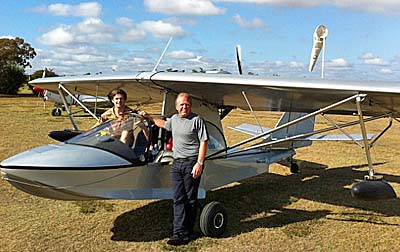
Michael Smith and son pose with the Southern Sun Searey.
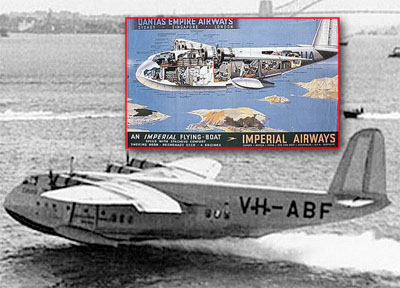
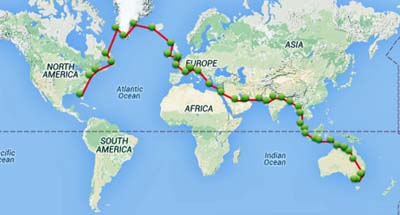
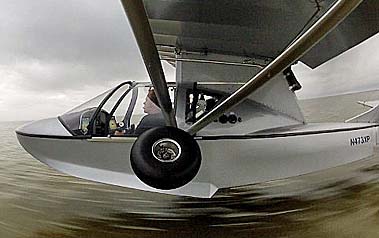
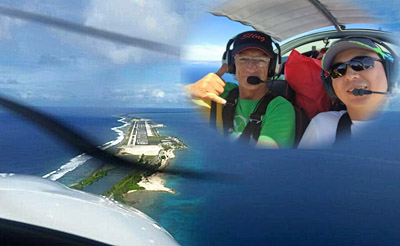
Surely a very welcome sight for two aviators who need a stretch: Majuro (PKMJ) in the Marshall Islands
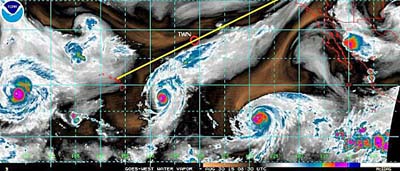
Yellow line is the route and red circle is where the Sling pilots were at the time. Yikes!
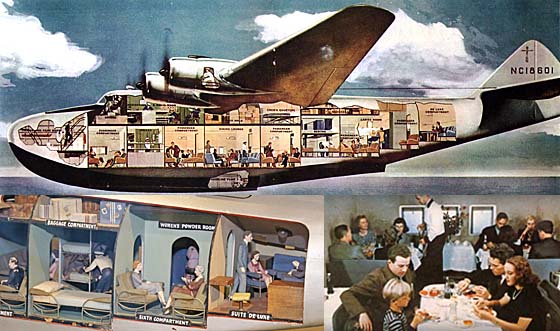
Similar to the Quantas flying boat, Boeing’s B-314 had multiple levels, large passenger compartments, a dining room, and seat unfolded to become beds. In the nearest engine nacelle, a mechanic works on the engine in flight. Flight crew had large tables to review maps.
Among the critiques some old school pilots employ when trying to marginalize Light-Sport Aircraft is that these aircraft are not suited to flying long distances. I’ve reported several around the world flights (check this article and here’s another) but that’s hardly all the long flights.
The invitation started out, “Join all of us at Progressive Aerodyne and the City of Tavares on Friday, September 11 for a presentation by Michael Smith about his epic Searey flight from Melbourne, Australia to Central Florida. Michael will give a presentation at the beautiful Tavares Pavilion on the Lake about his incredible journey.” Unfortunately, I can’t attend as I’ll be working the Midwest LSA Expo in Mt. Vernon, Illinois that weekend. However, many readers probably cannot attend either so here’s a bit of Michael’s story.
In the not-too-distant past, documenting a trip like his probably meant appealing to a magazine or publishing a book. Either would be challenging and by the time it was printed and distributed, it would be dated. Thank goodness for the Internet and a website called TravelPod that allowed many to follow in near real time.
At the outset, Michael wrote, “The plan is to loosely follow the Qantas Empire Flying Boat route of 1938 from Sydney to London in the Searey amphibian aeroplane named ‘Southern Sun.'” Of course, Quantas was a giant flying boat and the S.S. Searey is tiny plus Michael would fly solo.
His blog continued, “The story of the grand flying boats on the pre-war era I found captivating. All of the research I was doing [for my flight] came together when [I visited] an excellent exhibition of the Flying Boat era in Sydney. I snapped up photos of dsplays, maps, itineraries and the like, and decided, one day, I would really like to do that.”
Michael notes that his Searey has “a similar range to the flying boat airliners of 1938 … just a little less amenity and comfort.” He observed, “Those planes were conceived with [ocean-crossing] ship comfort in mind, with three levels of decks, lounge chairs, even mini golf.” Then he added dryly, “I lack most of those facilities …”
Unlike a record-setting dash, Michael chose to make his an enjoyable expedition, pausing in each city for a day or two “to seek out the old landing spots and hotels that were used” by the airline companies. For those of you who read his travel blog, you can find plenty of info with numerous photos chronicling his discoveries along the route.
While the first legs allowed more frequent stops, departing England got serious. Admitting that unlike the airlines, “I don’t have the range to do Ireland to Canada direct,” Michael shows his explorer side saying, “I’ve always been keen to see a few islands in the North Atlantic.”
This comment sums up the North Atlantic crossing, “Deep down … I was apprehensive about this flight. It was only a 575 mile leg, and while I had fueled the plane close to the gills to give me spare range, it’s a long passage over some very cold water.”
You might think he would simply climb to the safest altitude but that’s not possible Michael discovered. “Flying VFR over the Atlantic means staying out of controlled airspace, which starts at 6,000 feet, and as [I was] heading west that meant 4,500 feet.” It is more important to watch winds at various levels to minimize fuel use. Having extra height to extend a glide is less meaningful over the North Atlantic. Despite his apprehension, 9.2 hours later he landing in Iceland.
I recommend you read about Michael’s long trip via his regular posts on TravelPod . He’s quite an engaging writer and in this way you can follow his experiences. I found it a fascinating travelogue.
Is Michael done with these long distance flight? It certainly does not sound like it, and after a success flying half-way around the world, who knows? Here’s how he ended his 53-part travel blog, “I’m flying home with Qantas on Monday. On the whole ‘what’s next question,’ that needs some thinking, but I do note on today’s track map there is an interesting island south of Florida that Americans can’t currently visit …” I’ll bet we see more from Michael.
Another Very Long Flight Underway … In a completely different attempt, we continue following the flight of a Sling LSA as it circles the globe. (See earlier article.) Flying even farther than Michael Smith and the SS Searey, these fellows have no boat hull under them as they cross two oceans. However, they have experience as TAF aircraft have now three times done a circumnavigation of the Earth. So much for LSA not flying long distances (though one of the TAF flights was their four seater, presently built as a Experimental).
The U.S. Sling company wrote, “The 2015 Sling Around the World Expedition is once again underway! After a month’s rest in Los Angeles, Patrick Huang of the Airplane Factory Asia was joined by Jean d’Assonville of The Airplane Factory USA, a veteran Sling circumnavigator, and the two took off from Torrance, California for Hawaii on Saturday, August 29th.
“Once situated in their trusty steed — the South African registered Sling ZU-TWN — the pair made a quick fuel stop in San Luis Obispo, CA (KSBP) and then began the non-stop flight to Hawaii. They originally planned for a stop in Maui, but after favorable tailwinds and a fuel burn of 4 GPH, they amended plans and flew even further to Honolulu, PHNL. Total flight time was around 21.5 hours and fuel used was 102 gallons.
“After a check of the weather they determined it would be best to make a quick turn around and were back in the air the very next day. They took off from Honolulu at 7:38 Pacific time on Monday, August 31st and began the long journey to Majuro (PKMJ) in the Marshall Islands. They were in constant communication with TAF’s team in both the USA and South Africa, who navigated them around a few Pacific Ocean storms (image). Some favorable tailwinds were seen initially and after 19.5 hours and over 2,000 nautical miles, they landed on the beautiful coral atoll of Majuro.”
The Sling trip is underway as this is written but, as with Michael Smith’s voyage, you can follow the pair en route. This blog link describes the trip. Or go to TAF USA’s Facebook page.


Leave a Reply